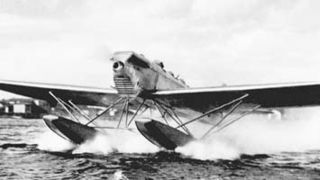
The Heinkel He 111 was a German bomber aircraft designed by Siegfried and Walter Günter at Heinkel Flugzeugwerke in 1934. Through development it was described as a "wolf in sheep's clothing". Due to restrictions placed on Germany after the First World War prohibiting bombers, it masqueraded as a civil airliner, although from conception the design was intended to provide the nascent Luftwaffe with a fast medium bomber.

The Heinkel He 113 was a fictitious German fighter aircraft of World War II, invented as a propaganda and possibly disinformation exercise.

The Heinkel He 116 was an extremely long-range mail plane designed to deliver airmail between Germany and Japan. Several examples were built for this role, as well as a small batch to be used in the long-range reconnaissance role.

The Heinkel He 118 was a prototype German monoplane dive bomber design that lost out to the Junkers Ju 87 Stuka in the 1930s, and was never ordered by the Luftwaffe.

The Aichi D1A or Navy Type 94/96 Carrier Bomber was a Japanese carrier-based dive bomber of the 1930s. A single-engine, two-seat biplane based on the Heinkel He 50, the D1A was produced by Aichi for the Imperial Japanese Navy, remaining in service as a trainer at the time of the attack on Pearl Harbor. The D1A was produced in two variants, the D1A1, and the D1A2.

The Yokosuka R2Y Keiun was a prototype reconnaissance aircraft built in Japan late in World War II.

The Heinkel He 72 Kadett ("Cadet") was a German single-engine biplane trainer of the 1930s.

The Gotha Ka 430 was a military transport glider, first built in 1944. The glider was designed by Albert Kalkert. Twelve had been produced by the end of World War II, but none of them was used operationally.

The Heinkel HD 42 50, later designated the Heinkel He 42 was a German two-seat biplane seaplane originally designed for the Deutsche Verkehrsfliegerschule, and later built for the German Luftwaffe. The aircraft was used until the end of World War II as a trainer for maritime pilots.

The Heinkel He 2, produced in Sweden as the Svenska S 3 and nicknamed the "Hansa", was a reconnaissance floatplane built in small numbers to equip the Swedish Navy in the 1920s. It was a refinement of the HE 1, sharing its same basic configuration as a low-wing, strut-braced monoplane with no tail fin and a rudder that barely protruded above and below the line of the fuselage.

The Heinkel HE 8 was a reconnaissance floatplane built in Germany in the late 1920s. It was developed at the request of the Danish Navy, which had noted the success of the HE 5 in Swedish service, and wished to purchase a similar aircraft as well as licensed production as the Orlogsvaerftet HM.II. Apart from its new Armstrong Siddeley engine, the HE 8 also differed from the HE 5 and previous members of the HE 1 family in having a conventional empennage. 22 aircraft were operated until the German invasion in 1940, after which one example was impressed into Luftwaffe service and the remainder placed in storage.

The Heinkel HD 32 was a trainer developed in Germany in the 1920s, a derivative of the HD 21. Like that aircraft, it was a conventional, single-bay biplane, but had only two cockpits rather than the three that the HD 21 had. The other significant change was the use of a Siemens radial engine in place of the inline units that powered most of the HD 21 family.

The Aichi E3A was a reconnaissance seaplane developed in Germany as the Heinkel HD 56 to operate from warships of the Imperial Japanese Navy, which designated it the Type 90-1 Reconnaissance Seaplane. It was a conventional single-bay biplane with staggered wings braced by N-type interplane struts. The pilot and gunner sat in tandem, open cockpits.

The Blohm & Voss Ha 140 was a German multi-purpose seaplane first flown in 1937. It was intended for use as a torpedo bomber or long-range reconnaissance aircraft, but did not enter production.

The Gotha Go 150 was a light aircraft designed at the German company Gothaer Waggonfabrik in the late 1930s. It was intended for civilian use, but ended up being used as a military trainer.

The Focke-Wulf 1000x1000x1000, also known as Focke-Wulf Fw 239, was a twin-jet bomber project for the Luftwaffe, designed by the Focke-Wulf aircraft manufacturing company during the last years of the Third Reich.
The Mitsubishi G7M Taizan was a proposed twin-engine long-range bomber designed for use by the Imperial Japanese Navy in 1941.
The Heinkel HD 16 was a single-engine biplane torpedo aircraft developed by the German aviation company Ernst Heinkel Flugzeugwerke in the nineteen-twenties and produced under license by Svenska Aero in Stockholm, Sweden.

The Heinkel HE 9 was a reconnaissance seaplane developed by the German aviation company Ernst Heinkel Flugzeugwerke AG in the late 1920s.
The Heinkel HE 7 was a reconnaissance torpedo-bomber developed by the German aeronautical company Heinkel Flugzeugwerke in the late 1920s.
















